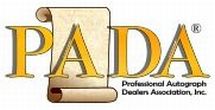1431499
Maxfield Parrish
Scroll down to see the image of the item below the description
Huge classic signature of the American artist
Frederick Maxfield Parrish, 1870–1966. American painter and illustrator. 3½" x 5½" card signed, Maxfield Parrish, dated April 20th - 1930.
Parrishʼs classic signature is art unto itself, and this one is as beautiful as one will see. Parrish has penned a huge, classic 3" signature in black fountain pen. His capital “P" in "Parrish" is a full 1" high. Beneath his signature, Parrish has added the place, “Cornish, New Hampshire,” the date, and his mailing address, “P.O. Windsor, Vermont."
Parrishʼs reference was undoubtedly to the Cornish Art Colony, centered in Cornish, New Hampshire, where some 100 notable artists, sculptors, writers, designers, and others lived, either full time or during the summer months. The principal resident was Augustus Saint-Gaudens, the leader of the American Renaissance movement renowned for his equestrian statues and for his design of the $20 double eagle gold piece, which many consider the most beautiful American coin. The Colony took its name from the village of Cornish, its social center, but it extended over the area to Plainfield, New Hampshire and to Windsor, Vermont, which, as Parrish notes here, was the mailing address for the area.
Parrish himself lived there year round. At age 28, he bought land in Plainfield, New Hampshire, near his parentsʼ home, and built his home and his studio, The Oaks, there. He spent the rest of his life there, first with his wife, Lydia, who died in 1953, and later with his friend and model, Sue Lewin, until he died in 1966.
By the time he was 30, Parrish had become one of the most successful and prolific artists of the Golden Age of Illustration. He earned more than $100,000 per year—some $2.5 million by todayʼs standards. His early work as an illustrator of such prominent books as Mother Goose in Prose (1897), Eugene Fieldʼs Poems of Childhood (1908), and Arabian Nights (1909) and for magazines such as Hearstʼs, Colliers, and Life eventually gave way to painting. He produced a number of androgynous nudes in fastastical settings before turning to landscapes in 1931, the year after he signed this card. His work was characterized by dazzingly luminous color, which he achieved by applying bright layers of oil paint alternately with layers of varnish in a technique known as “glazing,” with a three-dimensional appearance.
Parrish has written and signed this piece on a collectorʼs imprinted note card. The imprinting could be matted out if the piece were framed. There is a light, unobtrusive vertical crease through the center that affects a couple of letters. The piece is in fine condition.
Unframed. Click here for information about custom framing this piece.
Please click here to contact us regarding the availability of this item.





